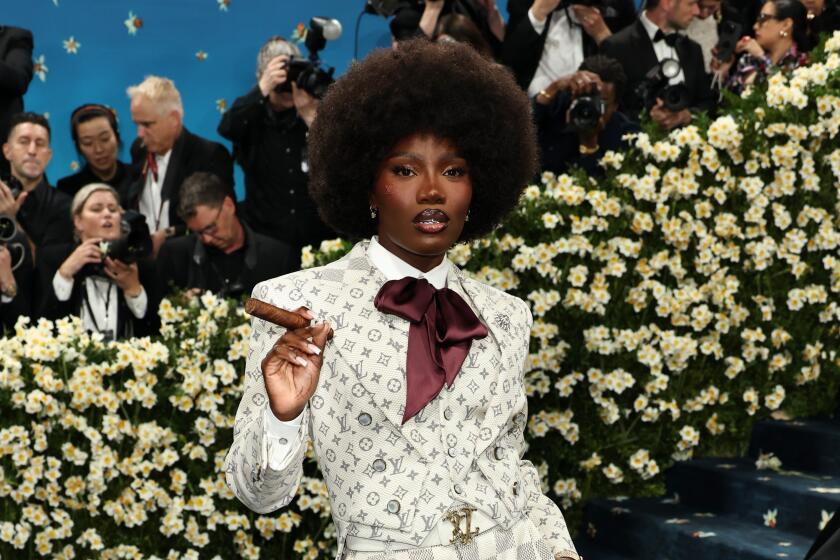New movements from Israeli dancers
- Share via
Ronit Ziv doesn’t believe in movement for movement’s sake. Niv Sheinfeld considers postmodernism passe and yearns for art to be less cynical. Idan Cohen is interested in the kind of work that others “only dare perform for the mirror.”
Ziv, Sheinfeld and Cohen are all award-winning choreographers based in Tel Aviv. But for the last two weeks, they have been in residence at UCLA with Israeli American choreographer Barak Marshall, bringing a taste of contemporary dance from their homeland to students who auditioned to work with them.
As Judy Mitoma, director of the UCLA Center for Intercultural Performance, said last week, “You don’t get many chances to see this generation of Israeli choreographers in the United States.”
Indeed, as an exporter of contemporary dance, Israel is probably still best known for the much-praised, Tel Aviv-based Batsheva Dance Company, founded in 1964.
But in recent years, a number of other troupes and independent choreographers have seen their profiles rise, particularly in Europe. All four of these choreographers have toured widely and/or won prizes there.
The residency, called “Bridge: Choreographic Dialogues,” was initiated by Marshall and sponsored jointly by the UCLA center and the Tel Aviv/Los Angeles Partnership of the Jewish Federation of Greater Los Angeles. It’s the second half of a cultural exchange that began last summer, when a trio of choreographers from Los Angeles went to Tel Aviv to work with dancers there, and will culminate in a performance Sunday afternoon at UCLA’s Glorya Kaufman Hall.
“I think one reason why choreographers in Israel develop such unique, distinctive voices comes from not having to appease a historical beast,” Marshall, who lives and works in both Los Angeles and Tel Aviv, said one recent morning.
“Israel is a young country, so there’s no long tradition of dance like there is in Europe, and people are encouraged to experiment. Plus, the Israeli attitude doesn’t recognize limits.”
Marshall, 39, is the son of Margalit Oved, a highly regarded Yemeni dancer and choreographer. He grew up in L.A. “running away” from his mother’s legacy. But in 1994, he moved to Israel to help her run a dance company and then stumbled upon a choreographic career of his own.
“I was just doing administration,” he recalled. “But then my aunt passed away, and in my grief, I went to the studio and started jumping around. I think my not having any formal training allowed me to create movement without worrying about aesthetic norms.”
His kinetic expressions of sorrow eventually gave way to a powerful body of work that fused his Yemeni-Israeli heritage with an American sensibility.
It attracted the attention of Ohad Naharin, the artistic director of Batsheva, who asked him to be that company’s house choreographer. He remained with the troupe until he broke a leg several years ago and the injury prompted him to return to Los Angeles.
“I’m both an insider and an outsider,” he said. “But as a choreographer, I’m definitely Israeli.”
Ziv, 37, offered a similar perspective.
“I can create anywhere, but it’s Israel that has made me a choreographer,” she said. “As an Israeli, you need to be strong, but you also have a need to escape to some shelter. The studio is my shelter.”
Ziv initially studied acting but always knew there “was something between theater and dance. . . . I was told I would have to decide, but I knew that when I run, jump and exhaust myself physically, that’s when I can talk.”
Cohen too originally studied acting in addition to the visual arts and piano. Now 29, he also grew up on a kibbutz as one of the last generation of Israelis raised in communal quarters.
“This was both good and bad,” he said. “A kibbutz is like a family, and you know how families can be.”
At 19, he started taking dance classes and a year later was accepted into the Kibbutz Contemporary Dance Company. He stayed with it for seven years before striking out on his own. “My work keeps getting dirtier and rougher,” he said.
Asked what that might have to do with living in the Jewish state, he said, “Israel has depth, controversy, intensity and warmth -- and you are a part of this no matter what.”
For his part, Sheinfeld, 35, observed that dance in Israel usually “isn’t political.”
“Everyone thinks that Israel is all about war, and it’s not,” he said. “But in Israel, you need to be strong and vital to survive, and I think choreographers bring this kind of energy to their work. It’s a kind of urgency.”
Trained as a gymnast, Sheinfeld began dancing with choreographers Liat Dror and Nir Ben Gal, who had founded a dance center in the Negev Desert. His first piece, “Borderline,” won a prize and launched his career in choreography.
“I’m always looking for some kind of expression and for how to turn a movement into something practical or psychological,” he said.
“I’m also looking for tenderness and comfort. My generation was born into this postmodern era, and we can be very cynical.”
Echoing Ziv, Marshall noted that “there’s an escapist and cathartic quality to the creation of dance in Israel.”
“People are expecting much more political art. But because the politics are so ever-present, choreographers, when they get into the studio, seek to escape that. The politics is already in their bodies. This gives Israeli dance a lot of layers.”
--
‘Bridge: Choreographic Dialogues’
Where: Glorya Kaufman Theater, UCLA campus
When: 2 p.m. Sunday
Price: $20
Contact: (310) 825-2102 or www.tickets.ucla.edu
More to Read
The biggest entertainment stories
Get our big stories about Hollywood, film, television, music, arts, culture and more right in your inbox as soon as they publish.
You may occasionally receive promotional content from the Los Angeles Times.









